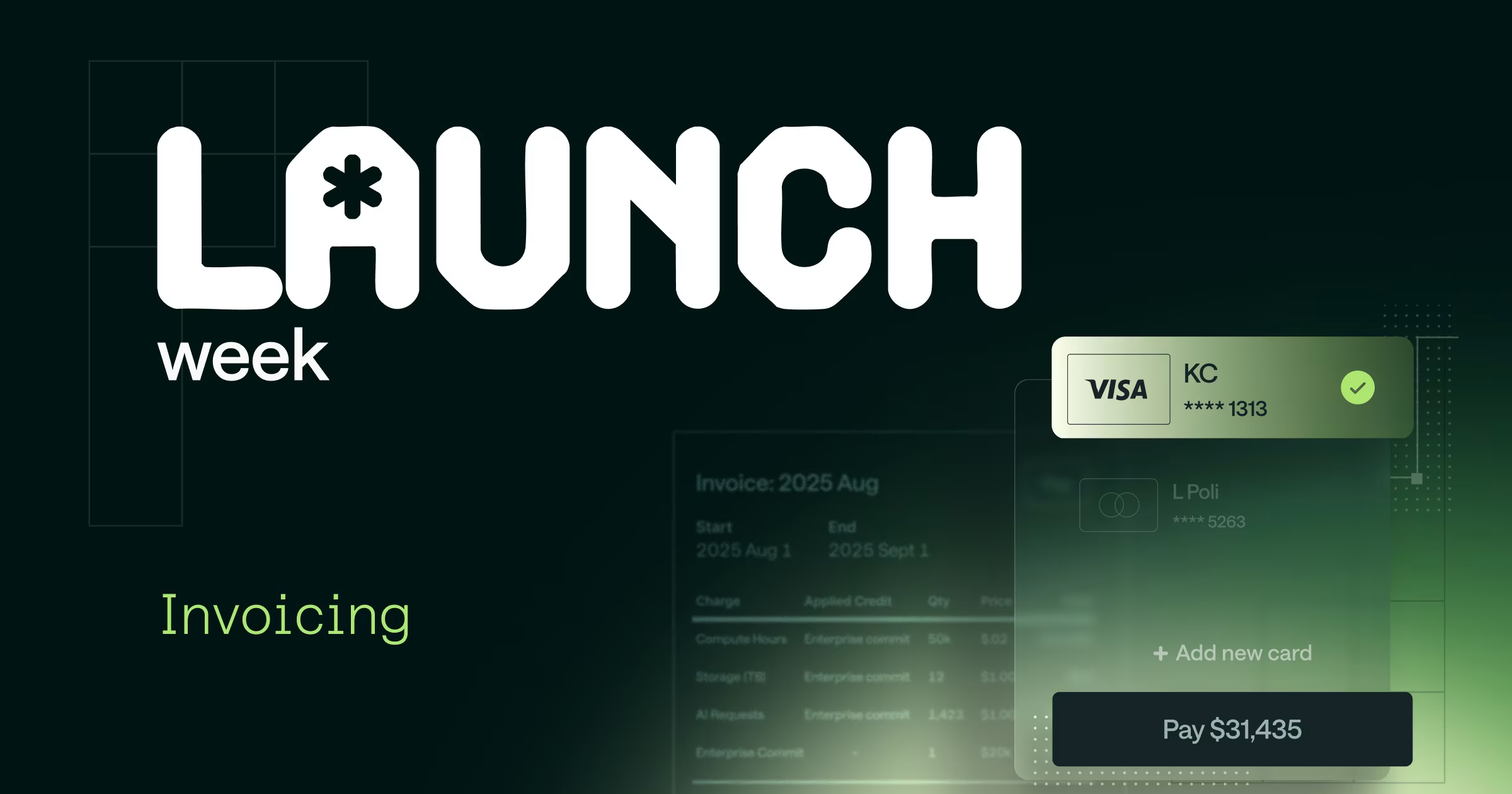Share
OpenAI processes billions of API calls daily. Anthropic handles massive language model inference workloads. Databricks bills customers for compute jobs that can spike from hundreds to millions of processing units in hours.
These companies represent a new category of software that traditional billing systems simply weren’t built for.
AI companies are becoming the most demanding billing customers in software history. Their usage patterns break every assumption that traditional subscription billing was built on: predictable usage, stable pricing,
These companies are creating entirely new requirements that will become the standard for all software companies as AI drives a shift toward outcome-based pricing. The billing vendors who understand this transformation early will own the next decade of software infrastructure.
Why traditional billing systems break with AI workloads
AI usage patterns break traditional subscription billing infrastructure because traditional billing systems can’t handle the complexity of AI workloads.
They aren’t built for tracking real-time usage, unpredictable demand, and value tied to outcomes, not licenses.
AI changes everything about usage
Traditional SaaS usage is predictable. A customer relationship management (CRM) customer might create 50 contacts one month and 55 the next. Email marketing customers send similar volumes each month with seasonal variations. Project management usage grows gradually as teams expand.
But AI workloads behave completely differently. A customer might process 1,000 documents on Monday and 100,000 on Tuesday. GPU usage can spike from idle to maximum capacity within minutes. Token usage can vary by 10x based on query complexity and user behavior patterns that change daily.
AI systems optimize, iterate, and act on their own, creating usage patterns that traditional billing systems cannot predict or handle.
Think about a customer scaling from prototype to production AI workloads. Their monthly bill might jump from $500 to $50,000 as they launch their product, then drop to $5,000 as they optimize their models, then spike to $80,000 during a marketing campaign.
Traditional billing systems designed for subscription predictability aren’t built for this volatility.
The instrumentation problem
Traditional SaaS tracks simple events: user logins, emails sent, projects created. AI companies need to track complex computational events: GPU seconds consumed, inference calls completed, tokens processed, model training hours, and compute resource allocation across multiple infrastructure providers.
Each event carries metadata that affects billing: which model was used, what hardware accelerated the computation, how much memory was consumed, which geographic region processed the request. This granular data must flow from product systems to billing systems in real-time without aggregation that could lose pricing details.
Legacy billing systems were built for workflow management, not data processing, making them unable to handle this complexity. Adding AI usage tracking to traditional billing platforms requires extensive custom development most engineering teams cannot sustain long-term.
Revenue recognition becomes harder
AI companies often combine multiple pricing models in single customer relationships. A customer might pay a base subscription fee for platform access, usage charges for compute consumption, outcome fees for successful AI predictions, and enterprise commitments for guaranteed capacity.
Each pricing component requires different revenue recognition treatment and billing presentation. Usage charges recognize immediately upon consumption. Outcome fees recognize when deliverables complete. Enterprise commitments recognize over contract periods with usage tracking for overages.
Traditional billing systems handle subscription revenue recognition but struggle with variable consideration, outcome-based recognition, and hybrid models that combine multiple recognition patterns in single accounts.
{{widget-monetization-whitepaper}}What AI companies demand from billing systems
AI companies need three core capabilities that traditional billing vendors miss: real-time usage processing, rapid pricing deployment, and hybrid outcome models.
Demand 1: Real-time usage processing at scale
AI workloads generate enormous volumes of granular usage data. Every token, image, or GPU hour becomes an event that needs to be tracked, priced, and recorded. Billing systems must process these events in real time and at scale to support accurate invoicing, revenue recognition, and spend transparency.
This isn’t theoretical. In production AI systems, token-based models can generate thousands of events per second per customer. Training runs can involve hundreds of GPUs across distributed infrastructure, each producing continuous streams of usage. The scale and frequency of these events turn billing into a real-time data problem.
Traditional billing systems aren’t designed for this. They process usage in batches—daily or weekly—which introduces lag and hides critical signals from both customers and internal teams. Pre-aggregating data upstream may ease the load, but it removes the detail required for accurate billing breakdowns and usage insights.
That detail matters. AI usage patterns can spike unpredictably, and customers expect to monitor spend in real time. Without that visibility, budget overruns become common—and trust erodes fast. That’s why platforms like OpenAI and Anthropic offer real-time usage dashboards. They’re meeting a clear operational requirement, not just delivering a nice-to-have feature.
Supporting this level of performance requires billing infrastructure built to handle real-time streams at scale. High-throughput event pipelines, horizontal scalability, and data consistency across distributed systems are now core requirements. Meeting this demand isn’t optional—it’s the baseline for billing AI workloads effectively.
Demand 2: Rapid pricing updates tied to compute costs
AI companies need billing systems that can quickly adjust pricing to reflect changing compute costs and competitive pressures using metrics that directly correlate with infrastructure economics..
Why AI pricing changes frequently
Cloud compute costs fluctuate as infrastructure providers adjust pricing for GPUs, storage, and network resources. Model efficiency improvements allow companies to reduce costs and pass savings to customers. Competitive pressure drives frequent pricing adjustments as companies optimize for market positioning.
AI companies need pricing models that reflect actual compute economics, like:
- GPU seconds
- Inference calls
- Tokens processed
- Node-hours consumed
These metrics directly correlate with infrastructure costs and allow companies to maintain healthy unit economics as usage scales. Traditional software metrics like seats, projects, or storage volume create misaligned economics that become unsustainable at scale.
OpenAI made multiple pricing adjustments throughout 2024, reducing API costs as model efficiency improved. Each pricing change required billing system updates that traditional subscription platforms cannot handle quickly.
Deployment speed requirements
Companies need to deploy pricing changes in minutes when compute economics change, not months required by traditional billing systems. When a cloud provider reduces GPU costs by 20%, AI companies want to pass those savings to customers immediately to maintain a pricing advantage.
Traditional billing systems require engineering work to implement pricing changes: updating database schemas, modifying billing logic, testing invoice generation, and coordinating deployment across multiple systems. This process can take weeks or months for complex pricing changes.
Modern AI billing platforms enable pricing changes through configuration interfaces that deploy new rates instantly across all customer accounts. Databricks can update its DBU pricing model quarterly to reflect actual compute costs rather than being locked into annual pricing contracts.
Demand 3: Hybrid pricing models
AI companies need billing systems that can handle complex pricing models mixing usage, outcomes, and subscription elements within single customer relationships.
Outcome-based pricing complexity
AI enables outcome-based pricing where customers pay for results rather than consumption: successful predictions, documents processed accurately, images classified correctly, or business outcomes achieved. These models require billing systems that can track both usage consumption and successful outcome delivery.
A computer vision company might charge per image processed plus success fees for accurate classifications above baseline thresholds. A document processing company might charge per page processed plus outcome fees for successful data extraction. These hybrid models require billing logic that traditional subscription systems cannot handle.
Multi-model billing requirements
AI companies often serve different customer segments with different pricing preferences. Self-service customers prefer pay-as-you-go usage pricing. Enterprise customers prefer predictable subscription fees with usage allowances. Partner customers need revenue-sharing models with complex calculation logic.
Supporting multiple pricing models requires billing systems that can handle free tiers, usage thresholds, seat-based plans, consumption overages, enterprise commitments, and custom contract terms within single accounts. Traditional billing systems handle one pricing model well but struggle with hybrid approaches that AI companies require.
Experimentation infrastructure
AI companies need billing systems that support A/B testing of pricing models, progressive rollouts to customer segments, and safe rollback mechanisms when experiments do not perform as expected. Pricing experimentation is crucial for AI companies because optimal pricing models are not yet established in most categories.
Traditional billing systems require extensive custom development to support pricing experimentation because they were designed for stable subscription models rather than continuous optimization of variable pricing approaches.
The infrastructure divide
Old billing systems cannot be retrofitted for AI requirements. The technical gaps are too large to bridge through incremental improvements.
Why legacy systems cannot adapt
Traditional billing systems were built as workflow platforms for predictable subscription billing, not high-throughput data platforms that process millions of usage events in real-time. The systems work differently and cannot be resolved through software updates or integrations.
Workflow platforms excel at moving invoices through approval processes, handling subscription changes, and managing customer account data. They process thousands of transactions daily with complex business logic for subscription management, dunning processes, and revenue recognition workflows.
High-throughput data platforms excel at ingesting massive event streams, processing data in real-time, and maintaining consistency across distributed systems. They process millions of events per second with optimized data structures for usage tracking, real-time analytics, and streaming computation.
Engineering resource allocation
Companies that attempt to build AI billing capabilities on legacy platforms typically allocate 25 to 40% of engineering resources to billing-related work: data pipeline maintenance, usage aggregation logic, pricing configuration systems, and customer-facing usage dashboards.
Billing can no longer be an afterthought and must be built on robust data infrastructure from the ground up for AI-scale requirements.
This engineering allocation represents a significant opportunity cost because those resources could be focused on competitive product development, customer experience improvements, or core AI model optimization instead of billing infrastructure maintenance.
Revenue recognition accuracy
AI pricing complexity creates revenue recognition problems that require manual work with old systems. Manual reconciliation between usage data and billing systems introduces errors, delays month-end close processes, and creates audit risks that scale poorly as revenue grows.
Companies with AI billing requirements report spending 3-5 days each month reconciling usage data with financial systems, compared to same-day close capabilities with purpose-built AI billing platforms.
Modern billing platforms built for AI workloads
Companies like Metronome have built billing infrastructure specifically for AI-scale requirements, processing billions of usage events in real-time for customers including OpenAI, Anthropic, and Databricks.
Technical infrastructure requirements
Modern AI billing platforms provide event pipelines that handle millions of events per second, modular pricing engines that deploy changes in minutes, and real-time data processing without pre-aggregation that could lose billing accuracy.
These platforms maintain real-time usage visibility for customer dashboards while ensuring accurate revenue recognition for financial reporting. They support hybrid pricing models that combine subscriptions, usage tiers, outcome payments, and enterprise contracts within single customer accounts.
What modern platforms do
Modern platforms eliminate the operational overhead that old systems create. Pricing changes deploy through configuration interfaces rather than engineering tickets. Usage data flows directly to financial reporting rather than through manual reconciliation. Customer usage visibility is real-time rather than batch-processed monthly reports.
Integration requirements
AI billing platforms integrate with product systems through APIs that capture granular usage events, connect with financial systems for automated revenue recognition, and provide customer-facing interfaces for usage monitoring and spend controls.
Building AI-ready billing capability
Finance, product, and engineering leaders need specific steps to evaluate and modernize their billing infrastructure for AI requirements.
Current state assessment
Map existing usage data sources and identify gaps between product telemetry and billing integration. Document current pricing change processes and measure time from decision to deployment. Assess revenue recognition accuracy and manual reconciliation requirements.
Most companies discover they cannot accurately track usage at the granularity required for AI billing and cannot deploy pricing changes quickly enough to respond to competitive pressure or cost fluctuations.
Build vs. buy decision
Evaluate build versus buy decisions based on engineering resource allocation, time to market requirements, and long-term maintenance costs. Building AI billing capabilities internally typically requires 18-24 months for basic functionality and ongoing maintenance that consumes significant engineering resources.
Specialized billing platforms provide AI-ready capabilities immediately, with ongoing infrastructure maintenance handled by vendor engineering teams rather than internal resources.
Implementation approach
Start with hybrid pricing models that combine existing subscription revenue with usage-based components for AI features. Implement usage tracking and customer visibility before changing pricing models to ensure billing accuracy and customer acceptance.
Measure pricing deployment speed, revenue recognition accuracy, and customer satisfaction with billing transparency as success metrics for billing infrastructure modernization.
The new standard for all software
AI companies are raising the bar for billing infrastructure—and every software company will need to catch up. As AI becomes embedded in every product, real-time usage processing, fast pricing updates, and hybrid outcome models won’t be optional. They’ll be table stakes.
Billing has moved from the back office to the competitive edge. The companies that modernize their infrastructure now will outpace those stuck on legacy systems, with faster launches, smarter pricing, and better customer experiences.
The billing vendors that build for AI-scale demands will define the next decade of software infrastructure.
{{widget-monetization-whitepaper}}








.png)


%25202%2520(1).png)